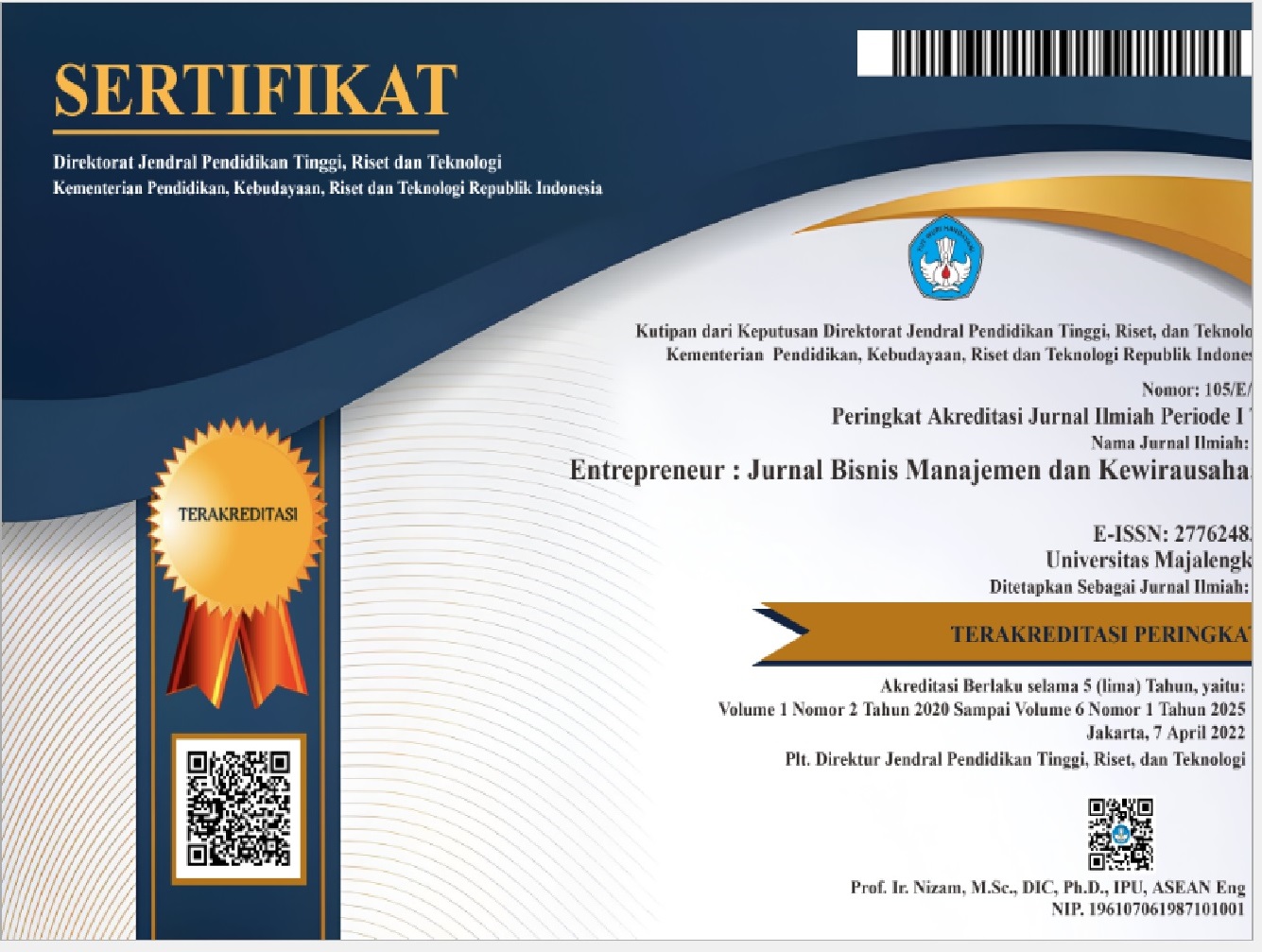Penanganan Kredit bermasalah Pada Perumda BPR Bank Gresik
DOI:
https://doi.org/10.31949/entrepreneur.v5i3.11516Abstract
Credit facilities are one of the services offered by BPR Bank Gresik, a financial organization that offers banking services to its customers. In providing this credit, BPR Bank Gresik experiences credit risk, namely credit is offered with interest that cannot be returned in accordance with the agreement that has been approved by the creditor and debtor. In bank financial management, problematic credit, or non-functioning credit, is a big problem. BPR Bank Gresik experienced various levels of problematic credit over the last five years, from 2018 to 2022. Improper credit management can result in losses. This research aims to overcome problem loans at "Perumda BPR Bank Gresik" and determine the best action to resolve problem loans. To explain how to manage and identify problem loans in banks, this research uses a qualitative descriptive research methodology. The problem with loans, according to researchers' findings, is that many customers deliberately do not make payments, and bank workers often neglect supervision, resulting in an annual growth in the value of non-performing loans (NPL) of more than 5%. Therefore, to prevent problematic credit, PERUMDA BPR Bank Gresik should "further increase supervision" of the credit provided, taking into account the condition of the debtor and its management. Banks also consider the requirements of prospective customers before providing credit to prevent problematic credit.
Keywords:
Credit lending, Non-performing loan, BPRDownloads
References
Agustina, D., Sari, W., Widianto, A., Studi, P., Politeknik, D. A., Bersama, H., Studi, P., Politeknik, D. A., Of, A., Performance, E., Issuance, I., Trading, O., Permits, B., The, A., Investment, S., Office, S., & Tegal, I. (2006). BUMIHARJA KABUPATEN TEGAL. 1–8.
Desda, M. M., & Yurasti, Y. (2019). Analisis Penerapan Manajemen Risiko Kredit Dalam Meminimalisir Kredit yang bermasalah Pada PT. BPR Swadaya Anak Nagari Bandarejo Simpang Empat Periode 2013-2018. Mbia, 18(1), 94–106. https://doi.org/10.33557/mbia.v18i1.351
Diyanti, A., & Widyarti, E. T. (2012). Analisis Pengaruh Faktor Internal dan Eksternal Terhadap Terjadinya Non Performing Loan. Diponegoro Journal of Management, 1(2), 290–299.
Firmansyah, A., & Fernos, J. (2019). Analisis Kredit yang bermasalah Dilihat Dari Standar Non Performing Loan (Npl) Pada Pt. Bank Perkreditan Rakyat (BPR) Prima Mulia Anugrah Cabang Padang. OSF Prepints Journal, 1(1), 1–13.
Hardani, dkk. 2020. Metode Penelitian Kualitatif & Kuantitatif. Yogyakarta: CV Pustaka Ilmu.Sugiyono. (2020). Metode Penelitian Kualitatif. Bandung:CV ALFABETA.
Kasmir, 2014, Dasar – Dasar Perbankan, PT. Raja Grafindo Persada, Jakarta
Kurniati, T., & Nurhayati, N. (2020). Analisis Kredit yang bermasalah Dilihat Dari Standar Non Performing Loan (Npl) Pada Pt. Bank Mandiri (Persero) Tbk. Inovator, 9(1), 17. https://doi.org/10.32832/inovator.v9i1.3001
Rahayu, Y. N., Putra, Y. E., & Susanto, R. (2022). Analisis Tingkat Kesehatan Bank Ditinjau Dari Non Performing Loan (NPL) Pada PT. BPR Batang Selo Padang Ganting. 1–13. https://osf.io/dsgjz/download
Reviandani, W., & Pristyadi. (2019) Pengantar Akuntansi. Indomedia Pustaka
Usriyati, R., Priyono, N., & Khabibah, N. A. (2022). Penanganan Kredit yang bermasalah (Non Performing Loan) Pada PT. BPR BKK Muntilan (Perseroda). Akuntansi Dan Manajemen, 17(1), 60–71. https://doi.org/10.30630/jam.v17i1.176

Published
How to Cite
Issue
Section
License
Copyright (c) 2024 Nur Fitri Aprilia, Anita Akhiruddin

This work is licensed under a Creative Commons Attribution-ShareAlike 4.0 International License.
COPYRIGHT NOTICE
An author who publishes in the Entrepreneur: Jurnal Bisnis Manajemen dan Kewirausahaan agrees to the following terms:
1. Author retains the copyright and grants the journal the right of first publication of the work simultaneously licensed under the Creative Commons Attribution-ShareAlike 4.0 License that allows others to share the work with an acknowledgment of the work's authorship and initial publication in this journal
2. The author is able to enter into separate, additional contractual arrangements for the non-exclusive distribution of the journal's published version of the work (e.g., post it to an institutional repository or publish it in a book) with the acknowledgment of its initial publication in this journal.
3. The author is permitted and encouraged to post his/her work online (e.g., in institutional repositories or on their website) prior to and during the submission process, as it can lead to productive exchanges, as well as earlier and greater citation of the published work







